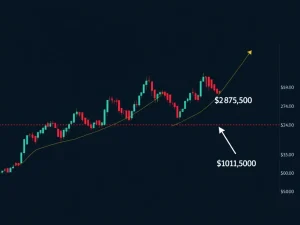Bitcoin’s **Remarkable** Illiquid Supply Set to **Soar** by 2032: Fidelity’s Insight

The future of Bitcoin’s illiquid supply holds significant implications for the cryptocurrency market. A recent Fidelity Bitcoin report reveals a compelling forecast. Asset management giant Fidelity anticipates a substantial increase in Bitcoin held by long-term investors and institutions. This trend could dramatically reshape Bitcoin’s market dynamics. Understanding this shift is crucial for anyone involved in digital assets.
Understanding Bitcoin’s Illiquid Supply Growth
Fidelity’s analysis projects that Bitcoin’s illiquid supply could reach 8.3 million BTC by 2032. This represents approximately 42% of the total circulating supply. Such a significant portion of Bitcoin would become unavailable on the open market. The firm defines illiquid supply using specific criteria. Bitcoin must show consistent quarterly increases in holdings, or at least 90% of the time over four years. This methodology helps identify true long-term commitment. Less available Bitcoin generally means increased scarcity. Consequently, this often positively influences Bitcoin price outlook.
The Two Pillars of Illiquid Holdings
Fidelity identifies two primary groups driving this illiquid trend. These cohorts consistently accumulate and hold Bitcoin:
- Long-term Bitcoin holders: These are wallets that have not moved Bitcoin for at least seven years. Their supply has not decreased since 2016, demonstrating strong conviction.
- Publicly traded Bitcoin treasury companies: These firms hold at least 1,000 BTC. This group has shown remarkable growth, with only one quarter of supply decrease in Q2 2022.
Together, these groups held over six million Bitcoin by the end of 2025. This accounts for over 28% of Bitcoin’s finite 21 million supply. This substantial accumulation underscores a growing institutional and enduring investor interest. It also highlights the strategic importance of Bitcoin treasury companies in the ecosystem.
Projecting Future Scarcity: Fidelity’s Bitcoin Report Details
Looking ahead, Fidelity provides a detailed projection for Bitcoin’s illiquid supply. The firm forecasts 8.3 million BTC becoming illiquid by the second quarter of 2032. This calculation assumes that long-term holders will continue their accumulation rate. This rate mirrors their behavior over the past decade. Notably, this projection does not even factor in new public companies joining the Bitcoin holding ranks. By Q2 2025, Bitcoin’s circulating supply was roughly 19.8 million. Of this, an estimated 42% will be illiquid by 2032. This increasing scarcity could profoundly impact market dynamics. Investors must therefore consider these long-term supply shifts.
The Role of Bitcoin Treasury Companies in Market Dynamics
The emergence of Bitcoin treasury companies significantly shapes the market. Currently, 105 publicly traded companies hold Bitcoin. These entities collectively own over 969,000 BTC. This sum represents 4.61% of Bitcoin’s total supply. Their consistent buying patterns reduce the available supply. This reduces selling pressure on the open market. Moreover, this trend suggests a maturation of Bitcoin as a corporate asset. Businesses increasingly view Bitcoin as a strategic reserve. This corporate adoption strengthens Bitcoin’s fundamental value proposition. It also reinforces the long-term holding narrative.
Navigating the Bitcoin Price Outlook and Whale Movements
While the long-term outlook appears bullish due to diminishing supply, short-term volatility remains a factor. The combined holdings of long-term investors and public companies are substantial. At the end of Q2, these holdings were valued at $628 billion. This value is based on an average price of $107,700. However, this raises questions about potential large-scale selling events. Bitcoin whales have recently sold nearly $12.7 billion in BTC over 30 days. This represents the largest sell-off since mid-2022. Such movements can cause temporary dips in the Bitcoin price outlook. For instance, Bitcoin’s price decreased by 2% in the past month. Therefore, monitoring whale activity remains crucial for market participants. These dynamics illustrate the complex interplay between long-term adoption and short-term market pressures.
Fidelity’s comprehensive Fidelity Bitcoin report highlights a transformative trend. The increasing Bitcoin illiquid supply points to a future of enhanced scarcity. This is driven by steadfast long-term Bitcoin holders and strategic Bitcoin treasury companies. While short-term fluctuations occur, the long-term Bitcoin price outlook appears robust. This ongoing institutional and retail accumulation suggests a strong foundational shift for Bitcoin. Consequently, its position as a digital store of value continues to strengthen.










